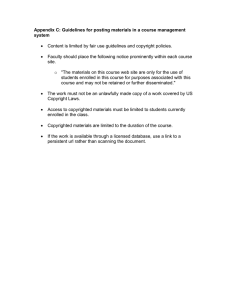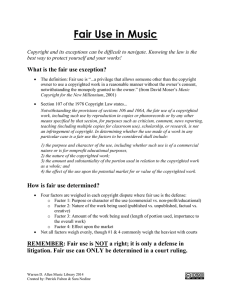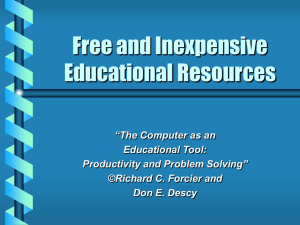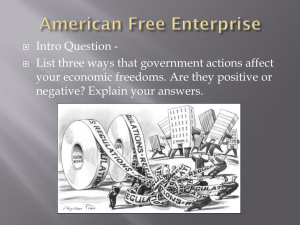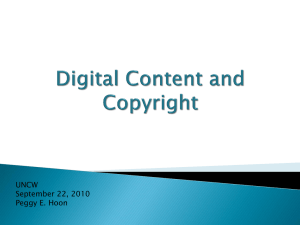Copyright and For-Profit Educational Institutions - Purdue e-Pubs
advertisement
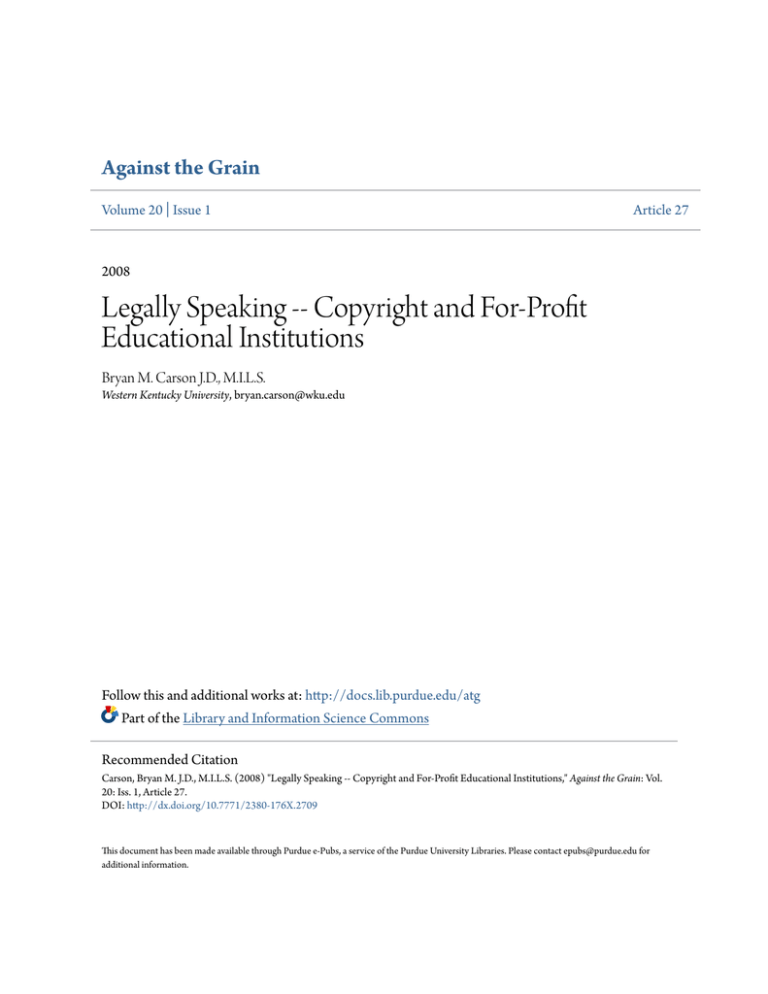
Against the Grain Volume 20 | Issue 1 Article 27 2008 Legally Speaking -- Copyright and For-Profit Educational Institutions Bryan M. Carson J.D., M.I.L.S. Western Kentucky University, bryan.carson@wku.edu Follow this and additional works at: http://docs.lib.purdue.edu/atg Part of the Library and Information Science Commons Recommended Citation Carson, Bryan M. J.D., M.I.L.S. (2008) "Legally Speaking -- Copyright and For-Profit Educational Institutions," Against the Grain: Vol. 20: Iss. 1, Article 27. DOI: http://dx.doi.org/10.7771/2380-176X.2709 This document has been made available through Purdue e-Pubs, a service of the Purdue University Libraries. Please contact epubs@purdue.edu for additional information. LEGAL ISSUES Section Editors: Bruce Strauch (The Citadel) <strauchb@citadel.edu> Bryan M. Carson, J.D., M.I.L.S. (Western Kentucky University) <bryan.carson@wku.edu> Jack Montgomery (Western Kentucky University) <jack.montgomery@wku.edu> Legally Speaking — Copyright and For-Profit Educational Institutions1 by Bryan M. Carson, J.D., M.I.L.S. (Associate Professor, Coordinator of Reference and Instructional Services, Associated Faculty — Library Media Education Program, Western Kentucky University Libraries, 1906 College Heights Blvd. #11067, Bowling Green, Kentucky 42101-1067; Phone: 270-745-5007; Fax: 270-745-2275) <bryan.carson@wku.edu> F or most of us in libraries, the issues surrounding copyright have been an allusive and sometimes misunderstood element of our working lives. There has been a wide push in recent years to add more content using multimedia to the classroom. While some studies have found statistically significant gains in student learning, others have found no measurable differences. Some researchers have attributed this lack to a difference in learning styles among students.2 Once learning styles were recognized and controlled for, however, it turns out that students who prefer visual learning styles do better with multimedia class material, while students with verbal/auditory learning styles perform at the same or lower levels with multimedia instruction.3 These findings suggest that teachers should include a variety of materials and work with all types of learning style preferences in order to maximize student performance.4 There are several rights that are included in copyright, including the right to transmit, reproduce, perform, and display. Most colleges rely on section 110 of the copyright statute (17 U.S.C. section 110). The first part of this section governs performance or display of a work in the course of face-to-face teaching, and the second part covers materials transmitted in distance education. However, these sections specifically state that they only apply to nonprofit educational institutions.5 As a result, the educational exceptions in 17 U.S.C. § 110(1) and 17 U.S.C. § 110(2) may not be used by for-profit schools. Distinctions between Nonprofit and For-Profit Schools? Most schools, colleges, and universities are either set up as nonprofit institutions, or are actually owned and operated by governmental entities. There are numerous state colleges, and some community and technical colleges that are operated by local governments or school systems. There are also several tribal colleges operated by Native Americans. And, of course, West Point, the U.S. Naval Academy, the Air Force Academy, and Gallaudet University are owned by the Federal government. Against the Grain / February 2008 A nonprofit college such as Harvard may not be owned directly by the state, but it has been given a charter to operate for a public purpose (in this case, educating people). Harvard is exempt from taxation. Because the Internal Revenue Service recognizes Harvard as a charitable organization under section 501(c)(3) of the tax code,6 donations made to the school are tax-deductible. Nonprofit institutions are prohibited from distributing profits to owners. On the other hand, the University of Phoenix is a wholly-owned subsidiary of Apollo Group. Apollo is an S&P 500 company which specializes in for-profit educational institutions. Their stock trades on the NASDAQ Stock Exchange (their ticker symbol is APOL). In the past 52 weeks, their stock has floated between $42.59 and $81.68 per share. The revenue earned by the University of Phoenix and other subsidiaries of Apollo Group is taxed by the Federal and state governments, and profits are distributed to the stockholders.7 The educational exceptions found in 17 U.S.C. § 110 are restricted to institutions that operate for a public purpose and are exempt from taxation under section 501(c)(3) of the tax code. If the institution is not tax-exempt, and if donations are not deductible, the education exemption doesn’t apply. Even if a college is nonprofit, it still must be accredited in order to take advantage of the distance learning provisions in section 110(2) of the Copyright Act. The accrediting body has to be one that is recognized by the Council on Higher Education Accreditation and the U.S. Department of Education. If the school is not accredited by a recognized accrediting agency, section 110(2) is not applicable. Fair Use The educational exceptions in section 110 are only one part of the equation, however. There is one other section in the copyright statute that should be considered: the Fair Use provision found in section 107 (17 U.S.C. section 107). In addition, as librarians we need to consider whether the underlying facts can be presented in a way that alleviates copyright concerns by using facts which are not subject to copyright. Lets examine each of these concepts in detail. The Fair Use provision of the Copyright Act is found in 17 U.S.C. § 107. This is the part of the statute that keeps copyright from infringing on constitutionally-protected speech.8 “Fair use gives the Constitution breathing space between the limits on expression inherent in copyright, and the freedom of expression guaranteed by the First Amendment.”9 Fair Use applies to both published and unpublished materials, although you can’t use as much material from an unpublished work as you can from a published work.10 The Fair Use provisions of § 107 read: [T]he fair use of a copyrighted work, including such use by reproduction in copies or phonorecords or by any other means specified by that section, for purposes such as criticism, comment, news reporting, teaching (including multiple copies for classroom use), scholarship, or research, is not an infringement of copyright. In determining whether the use made of a work in any particular case is a fair use the factors to be considered shall include — 1) the purpose and character of the use, including whether such use is of a commercial nature or is for nonprofit educational purposes; 2) the nature of the copyrighted work; 3) the amount and substantiality of the portion used in relation to the copyrighted work as a whole; and 4) the effect of the use upon the potential market for or value of the copyrighted work. The fact that a work is unpublished shall not itself bar a finding of fair use if such finding is made upon consideration of all the above factors.11 The four factors framed above are examined to determine whether a particular use of copyrighted material constitutes Fair Use. The first factor, the nature of the use, looks at whether it continued on page 58 <http://www.against-the-grain.com> 57 Legally Speaking from page 57 is for a commercial or a non-commercial purpose. The second factor involves determining whether the work is fiction or drama, nonfiction, educational, or factual. The third factor looks at the amount of material that is used, while the fourth is concerned with whether the use of the work will impair the market for the original material. A good place to find information on the four factors is Georgia Harper’s Copyright Crash Course Website.12 Although no single factor is given more weight in determining whether Fair Use applies, the most pressing questions that for-profit educational institutions must ask are whether the nature of the use is commercial and the character of the use. In a for-profit environment, the nature of the use will always be commercial. The principle cases on commercial use are American Geophysical Union et al. v. Texaco, Inc.,13 Basic Books, Inc. v. Kinko’s Copies,14 and Princeton University Press et al. v. Michigan Document Services.15 In the case of American Geophysical Union et al. v. Texaco, Inc.,16 the Texaco corporate library copied articles and sent them to scientists. The American Geophysical Union, a publisher of journals, sued Texaco for copyright violation. The District Court found that there was no fair use of the materials,17 and the Court of Appeals affirmed this decision.18 The decision of the appellate court is only binding law in the 2nd Circuit, which covers New York, Connecticut, and Vermont. However, the Court of Appeals decision has been cited many times, not only by lower courts, but also by the U.S. Supreme Court. Several other circuits have adopted the reasoning, including the 6th Circuit in the Michigan Document Services case. Thus, the Court of Appeals decision is currently the most authoritative statement governing fair use in a for-profit setting. According to the opinion, “courts will not sustain a claimed defense of fair use when the secondary use can fairly be characterized as a form of ‘commercial exploitation,’ i.e., when the copier directly and exclusively acquires conspicuous financial rewards from its use of the copyrighted material.”19 Two other important cases involved making the course packs so commonly used by academic faculty. The Kinko’s and Michigan Document Services cases involved making copies that were going to be used for educational purposes in not-for-profit universities. Nonetheless, both cases held that the commercial nature of the businesses, and the fact that these copies were subsequently sold, meant that the copy shops needed permission to duplicate in order to avoid copyright infringement. It did not matter that the materials were being put to an educational use. The commercial nature of the copy shops meant that Fair Use did not apply. The course pack cases also pertain to copying for library reserves. As a result of the Texaco case, a proprietary (private for-profit) educational institution such as the University of Phoenix would have to obtain copyright permission in order to make copies, even though a nonprofit educational institution such as the University of Arizona could do the same thing, and the duplication would be considered fair use. (But, of course, there are other questions related to the use of electronic reserves.)20 Because the use is considered commercial, the amount of material that can be displayed, performed, or reproduced for class is very limited. At this point, I would not recommend using films, music, or any other type of performances without obtaining permission. Similarly, reproducing copyrighted material as handouts would probably also be problematic, due to the for-profit status of the institution. I advise for-profit universities to obtain permission before reproducing materials, placing items on reserve in the library, or performing works in class. Display of Copyrighted Works Remember that displaying works is different from performing or reproducing them. This usually takes the form of charts, tables, graphs, and photographs which have been projected. In order to determine whether these items may be displayed in class, the Fair Use factors should be considered. We already know that the use is commercial, but it may still be possible to claim Fair Use — if the other three factors are in your favor. The amount of work used and the effect on potential market are often considered together. Number three asks how much was used, and number four looks at whether this use would substitute for people buying the copyrighted item. Impairment of value is usually — but not always — related to the use of a substantial portion of the copyrighted work. However, in one instance the publication of a 300-word excerpt from a 454-page book was found to have limited the potential market for the book and led to cancellation of a major contract. The case of Harper & Row, Publishers, Inc. v. Nation Enterprises21 involved the autobiography of former president Gerald Ford.22 When President Ford wrote his autobiography, The Nation magazine published an article about the book and included an unauthorized excerpt of about 300 words.23 Under normal circumstances, this short excerpt would not be considered to be substantial. However, in this case, the part that was quoted was the part that dealt with Ford’s decision to pardon ex-President Richard Nixon. This portion of the book was described as being among “the most interesting and moving parts of the entire manuscript.”24 Some have even said continued on page 59 Questions & Answers — Copyright Column Column Editor: Laura N. Gasaway (Associate Dean for Academic Affairs, University of North Carolina-Chapel Hill School of Law, Chapel Hill, NC 27599; Phone: 919-962-2295; Fax: 919-962-1193) <laura_gasaway@unc.edu> www.unc.edu/~unclng/gasaway.htm QUESTION: A museum is mounting an exhibition of LP record album cover art. These album covers are part of a few personal collections that are being loaned to the museum for the exhibition. The album covers will be exhibited strictly as examples of art produced for this medium. Does the museum need permission from the recording company in order to display the album covers? May the museum reproduce them on promotional materials or must it create its own designs for use in promotional materials? ANSWER: In recent years there has been considerable interest in the cover art on record albums — CDs just do not inspire the same art, probably due to the smaller size. This exhibit should attract a great deal of interest. The art- 58 Against the Grain / February 2008 work on album covers is copyrighted as with other works of art, assuming the requirements of copyright protection were met at the time. Assuming that the cover art is copyrighted, whether the recording company owns the copyright in the artwork or if the artist who created it owns the copyright is an important issue, but it need not be answered for the first part of this question. The owner of a record album has the right to display that copy publicly under the first sale doctrine embodied in section 109(a) of the Copyright Act. The owner of that copy has chosen to lend it to you for display, so the first sale doctrine that permitted the owner to display the work is transferred to the museum to display that copy publicly. Reproduction of the artwork on the cover presents another issue entirely. Using the art for promotional materials would require permission of the copyright holder, likely either the recording company or the artist, but either could have transferred the copyright to someone else. QUESTION: For mandatory regulatory filings, are for-profit companies required to get permission for providing copies of copyrighted works to government agencies? ANSWER: There is a strong argument that copies of articles required to accompany mandatory regulatory filings with various federal agencies are fair use. Even if they are not fair use, the Copyright Clearance Center’s continued on page 60 <http://www.against-the-grain.com> Legally Speaking from page 58 that it was the only reason why anyone would read the book.25 Every Fair Use decision requires careful scrutiny of the four factors. Each factor stands on its own, and each must be considered separately in order to determine whether the use is Fair Use. This analysis should be done each time before a use is made. Take, for example, a pharmaceutical horticulture class. During a lecture, a faculty member may wish to use a table or figure for illustration purposes. Suppose that I wanted to use a figure that showed regulation of ethylene responsive genes in the postharvest physiology of flower senescence. There is a great flow chart showing the process on page 819 of the Encyclopedia of Plant Sciences.26 The article has one figure, two tables, and 29 color photograph and illustration plates. One of the photographs and one of the illustrations are also relevant to the topic. We will look at the four factors to determine whether the use is Fair Use. 1. The nature of the use. We know that the use is com- This factor is against Fair mercial, because of the for- Use. profit status of the institution. 2. The nature of the copyrighted work. The Encyclopedia of Plant This factor is in favor of Fair is a non-fiction, factual, and Use. non-dramatic work. According to the publisher, it is “A multi-faceted reference work . . . [that] addresses the core knowledge, theories, and techniques employed by plant scientists, while also concentrating on applications of these in research and in industry.”27 Clearly this work is meant to be used as a factual resource. 3. The amount of the copyrighted material used. In this situation, the flow chart This factor is in favor of Fair and the two plates are very Use. small in comparison to the entire three volumes of the Encyclopedia of Plant Sciences. It appears to be a reasonable and limited amount of the work in question. Even compared to the 29 plates, using two plates appears to be reasonable. This factor is in favor of Fair Use. 4. The effect on the potential market. Displaying a few plates, ta- This factor is in favor of Fair bles, or figures in a lecture Use. does not impair the market for the original. In this analysis, three out of the four factors were strongly in favor of Fair Use. Thus, using a few tables, charts, figures, and illustrations from a factual non-fiction work would appear to be Fair Use — even in a for-profit setting — as long as the amount remains reasonable and limited and the use does not impair the market for the original. Against the Grain / February 2008 Facts That Are Not Copyrightable One final issue to consider when using material in a class is whether you can use facts that do not qualify for copyright protection. Under the Copyright Act, facts can’t be copyrighted. Compilations of facts may be copyrighted, but the underlying principle itself may not be. Even with compilations, there must be a spark of originality in the way that the editor selected or arranged the facts in order to qualify for copyright. The premier case dealing with compilations of facts was Feist Publications, Inc. v. Rural Telephone Service Co., Inc.28 This case dealt with the issue of whether telephone books could be copyrighted. The U.S. Supreme Court ruled that in compilations, it is the editorial effort of selecting and arranging the facts that constitutes originality. “These choices as to selection and arrangement, so long as they are made independently by the compiler and entail a minimal degree of creativity, are sufficiently original that Congress may protect such compilations through the copyright laws. Thus, even a directory that contains absolutely no protectible written expression, only facts, meets the constitutional minimum for copyright protection if it features an original selection or arrangement.”29 [Citations omitted.] In the Feist case, the Supreme Court found that arranging a telephone directory by the last name of the subscriber does not possess that “creative spark” of originality needed to trigger copyright protection.30 Since the physical properties of an organic compound are facts, they can be used in class. The periodic table, as an arrangement of elements by increasing atomic number, is simply a fact. The arrangement required no “creative spark.” Thus, the periodic table does not even qualify for copyright protection. Suppose the teacher wanted to use a table such as the “Bound Lengths Between Elements Other than Carbon,” which is table 3.4B in Dean’s Handbook of Organic Chemistry.31 This table does qualify for protection. However, the information presented in the table — that Diborane (B2H6) has a bound length of 1.77 Angstroms, for example — is not copyrightable. continued on page 60 <http://www.against-the-grain.com> 59 Legally Speaking from page 59 Conclusion Librarians and faculty members in for-profit schools face different challenges from those in nonprofit or governmental institutions. The educational exceptions found in 17 U.S.C. §110 are not available. This can have a substantial impact on the educational process. However, the principles of the fair use doctrine still apply, and for-profit schools may be able to claim a certain amount of fair use (although less than nonprofits would be able to use). It is even better, however, if for-profit institutions look for information and materials that are not subject to copyright, either because they are facts or because they are in the public domain. This will help keep away lawsuits, while still allowing students to access the materials they need in order to learn. Questions & Answers from page 58 annual copyright license covers electronic copies made to accompany regulatory filings, however. A corporate library also could seek to have these copies covered in its license agreements with publishers, QUESTION: A library recently had a visit from a contemporary children’s author and wants to create a Webpage with information about her and her works as represented in one of the library’s collections. The dust jacket images are eye-catching and would greatly enhance the Webpage. Is it permissible to use these images or must the library seek permission? ANSWER: The library would need permission to use the dust jacket images. The author is unlikely to hold the copyright in the jacket art unless she is also the artist, but she may be able to help the library obtain permission by working through her publisher. The publisher itself may not own the copyright in the artwork, but often the publisher only contracts with the artist to use the artwork on the jacket. In this situation, the publisher could not grant permission to the library to use the images on the Website. The publisher could help to identify the artist and locate him or her, however. QUESTION: When an academic library obtains a copy of an article for a user through interlibrary loan, may it place an electronic copy of the article on a password protected Website for the user to retrieve rather than placing a copy of the article in the campus mail or emailing it to the user? If so, how long may the library leave it on the Website for retrieval? ANSWER: Many libraries have adopted this practice even though the current section 108 of the Copyright Act does not envision such activity since it was adopted for an analog 60 Against the Grain / February 2008 Legally Speaking Endnotes 1. Many thanks to Jack Montgomery for helping me edit this article. He made some excellent suggestions, and for that I am grateful. However, any mistakes that you find are entirely mine. 2. Stephen M. Smith & Paul C. Woody, Interactive effects of multimedia instruction and learning styles, 27-3 Teaching of Psychology 220 at 220. 3. Smith & Woody at 223. 4. Smith & Woody at 223 5. In fact, § 110(2) specifies that they be nonprofit accredited institutions [emphasis added]. 6. 26 U.S.C. § 501(c)(3). 7. This information is from Zacks Investment Research. Retrieved February 13, 2008, from http://www.zacks.com. 8. Bryan M. Carson. The Law of Libraries and Archives. Lanham, MD: Scarecrow Press, 2007: 79. 9. David L. Lange, Theory and Practice in Copyright, Address at Intellectual Property in the Digital Age (University of Wisconsin School of Education/University of Wisconsin Law School, May 8, 2001). 10. Carson at 98. 11. 17 U.S.C. § 107. 12. Georgia Harper, Fair Use of Copyrighted Materials, Crash Course in Copyright, University of Texas System Office of the General Counsel (last modified January 30, 2003), available at http://www. utsystem.edu/ogc/intellectualproperty/copypol2.htm. 13. American Geophysical Union et al. v. Texaco, Inc., 60 F.3d 913; 1994 U.S. App. LEXIS 40786; 35 U.S.P.Q.2d (BNA) 1513; Copy. L. Rep. (CCH) at 27,417; 144 A.L.R. Fed. 745 (2d Cir. 1994). 14. Basic Books, Inc. v. Kinko’s Graphics Corp., 758 F. Supp. 1522, 1991 U.S. Dist. LEXIS 3804, Copy. L. Rep. (CCH) at 26709, 18 U.S.P.Q.2d (BNA) 1437 (S.D.N.Y. 1991). 15. Princeton University Press et al. v. Michigan Document Services, Inc., 99 F.3d 1381; 1996 U.S. App. LEXIS 29132; 1996 F.E.D. App. 0357P (6th Cir.); 40 U.S.P.Q.2d (BNA) 1641; Copy. L. Rep. (CCH) at 27,579 (6th Cir. 1996). 16. American Geophysical Union et al. v. Texaco, Inc., 60 F.3d 913; 1994 U.S. App. LEXIS 40786; 35 U.S.P.Q.2d (BNA) 1513; Copy. L. Rep. (CCH) at 27,417; 144 A.L.R. Fed. 745 (2d Cir. 1994). 17. American Geophysical Union et al. v. Texaco, Inc., 802 F. Supp. 1; 1992 U.S. Dist. LEXIS 16411, Copy. L. Rep. (CCH) P27013, 24 U.S.P.Q.2d (BNA) 1796 (S.D.N.Y. 1992). 18. American Geophysical Union v. Texaco Inc., 60 F.3d 913, 1994 U.S. App. LEXIS 40786, Copy. L. Rep. (CCH) P27417, 35 U.S.P.Q.2d (BNA) 1513, 144 A.L.R. Fed. 745 (2d Cir. N.Y. 1994). 19. Texaco at 922. 20. See my article in the September issue of ATG: Bryan M. Carson, Electronic Reserves and the Failed CONFU Guidelines: A Good Place to Start Negotiations, 19-4 Against the Grain 30, 32, 34. 21. Harper & Row, Publishers, Inc. v. Nation Enterprises, 471 U.S. 539; 105 S. Ct. 2218; 85 L. Ed. 2d 588; 1985 U.S. LEXIS 17; 53 U.S.L.W. 4562; 225 U.S.P.Q. (BNA) 1073; 11 Media L. Rep. 1969 (1985). (Hereinafter Ford Case.) 22. Gerald R. Ford, A Time to Heal: The Autobiography of Gerald R. Ford (Harper & Row 1979). 23. Behind the Nixon Pardon, 228-13 Nation 353 (April 17, 1979). 24. Ford Case at 565, quoting Reply Brief for Petitioners 16, n. 8. 25. David L. Lange, Theory and Practice in Copyright, Address at Intellectual Property in the Digital Age (University of Wisconsin School of Education/University of Wisconsin Law School, May 8, 2001). 26. E. J. Woltering. Senescence, Flowers. Encyclopedia of Applied Plant Sciences. Amsterdam, Boston: Elsevier Academic Press, 2003: 819. 27. Elsevier Academic Press. Encyclopedia of Applied Plant Sciences. (Last modified July 19, 2007.) Available at http://www.elsevier.com/wps/find/bookdescription.cws_home/673632/ description#description. 28. Feist Publications, Inc. v. Rural Telephone Service Co., Inc., 499 U.S. 340; 111 S. Ct. 1282; 113 L. Ed. 2d 358; 1991 U.S. LEXIS 1856; 59 U.S.L.W. 4251; 18 U.S.P.Q.2d (BNA) 1275; Copy. L. Rep. (CCH) at 26,702; 68 Rad. Reg. 2d (P & F) 1513; 18 Media L. Rep. 1889; 121 P.U.R.4th 1; 91 Cal. Daily Op. Service 2217; 91 Daily Journal DAR 3580. 29. Feist at 347. 30. Feist at 347. 31. George W. Gokel. Dean’s Handbook of Organic Chemistry. 2nd ed. New York: McGraw Hill, 2004: 3.17. world. On the other hand, only one user can retrieve the article, and one could argue that it is the equivalent of delivering one photocopy of the article to the user. Articles should remain available on a Website for only a limited time such as one to three weeks. A user would be alerted that the article is available on the Website with a single user password and that it will remain available for only X number of days. After that time, the article would be deleted even it the user has not yet retrieved it. QUESTION: What are the copyright issues regarding copying an assessment tool that was published in 1960 and reproduced continued on page 61 <http://www.against-the-grain.com>

